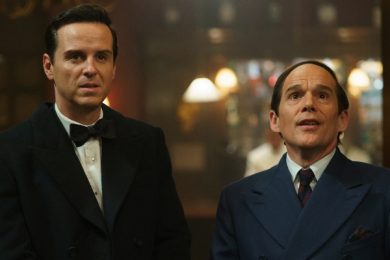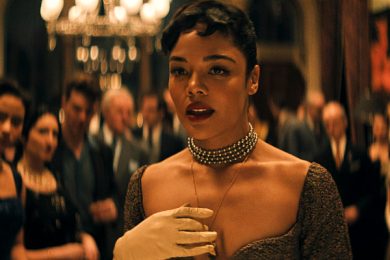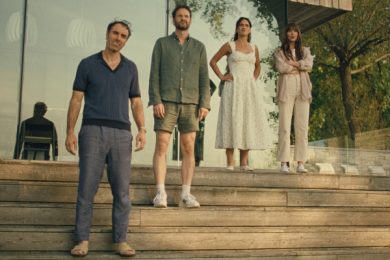Imagine, if you will, a movie for children that truly captures the full scope of everything that cinema has to offer, that doesn’t condescend to them with immature humor or overprotect them by hiding painful realities. In America, mainstream animated films are almost exclusively for children, but most of the highbrow stuff is fishing for adult prestige with a PG rating. The Wild Robot is based on a children’s novel by Peter Brown, which has become a trilogy, but the film adaptation – written and directed by Chris Sanders – does not feel hampered by literary obligation. The film strikes a perfect balance of stirring, tender, and intelligent without alienating their intended audience: kids.
The Wild Robot can immediately join the ranks of The Iron Giant and WALL-E within animated robot excellence. In all three films, the script masterfully finds the humanity within the automation. In Robot, our hero is ROZZUM Unit 7134, but who simply goes by Roz. She crash lands on a human-less island, which is problematic, since the ultimate goal for any ROZZUM helper robot is to complete tasks given to it by humans. Roz only meets a variety of wildlife, various rodents, birds, and one very angry bear. None of them appear to have a task for Roz to complete, but she keeps trying. She learns to communicate with the animals which makes the process only slightly easier, as now she’s introduced to the petty infighting between them all as they fight for space and supremacy across the island.
Here I’ll mention that Roz is voiced by Lupita Nyong’o, an Oscar-winning actor whose screen credits are too few for my liking. Nyong’o has defied expectation after 2013’s 12 Years a Slave. She’s found fulfillment off the screen just as often as on it. She’ll have presence in blockbusters like Black Panther, even if you wish the impact were larger. In Jordan Peele’s Us from 2019, she probably gave the best performance of her career, a feat unfortunately overlooked due to genre bias and a general unfairness to that movie at the time. She enjoys voice work, nearly half her Hollywood credits are roles where you never see her face. So perhaps that’s what makes her so perfect for The Wild Robot. This is a skill she’s honed, and she understands that there’s more to it than simply speaking into a microphone.
The plot of Wild Robot turns when Roz falls on a goose nest, accidentally killing all of its inhabitants except for a single egg. When that egg hatches, the small gosling sees Roz first thing and imprints upon her. It’s not until Roz gets some sage counsel from a mother opossum (Catherine O’Hara), that she understands: this gosling believes Roz is his mother. Finally, Roz is given a task she’s been searching desperately for: teach this gosling to eat, to swim, and to fly before the winter migration. Roz also gets some help from a more unlikely place, a dastardly fox named Fink (Pedro Pascal) who sees Roz and the gosling as a chance to move up in the island’s hierarchy. Over time, Roz, Fink, and the gosling (whom they name Brightbill) become an unlikely family, and Roz takes more and more to her role as caretaker.
As a runt, Brightbill’s chances of learning to fly before migration are slim. It doesn’t help that the rest of the island’s geese shun him as the offspring of the monstrous robot. If Brightbill (now voiced by Kit Connor) doesn’t make it off the island before winter, he will likely die in the harsh weather. So the stakes are high, showcasing the stark reality of life in the wilderness. As the story unfolds, Fink’s initially selfish motivations become pure and altruistic, Roz’s sparse mechanial personality turns warm and nuturing, and the ruthless animals of the forrest learn that coming together for each other might be preferable to battling along the food chain. Hanging over everything is the truth of what happened to Brightbill’s family, a truth that Roz decides to keep from her child.
From my memory, this feels like the first major studio kids movie that is, de facto, about parenting. Roz’s clinical process is turned upside down by Brightbill, quickly learning that caring for a child requires a lot of improvising, a skill she’s not programmed to possess. That she develops an emotional connection with her child is inevitable in a story like this, but Sanders’s script wisely skips any attempts at logical reasoning for the development of Roz’s soul – it’s there because Brightbill put it there. Sanders made his bones in 90’s Disney films before co-directing several features for Dreamworks Animation. The Wild Robot is a solo venture, and it showcases a filmmaker with a genuine eye for stunning imagery and a skill for narrative sequence. The Iron Giant comparison is apt in more ways than one, as Sanders should remind many of the multi-faceted skill of Brad Bird.
The movie’s brushstroke animation style gives the film an impressionistic feel. Dreamworks began working in this milieu first with The Bad Guys and Puss in Boots: The Last Wish. I haven’t seen those two films, but here the choice pays great dividends as it brings the story closer to its environment in a way that feels both like an artistic choice as well as holistic to the narrative. More than anything else, The Wild Robot is an incredible movie to look at, eschewing the photorealism so common in contemporary mainstream animation, and instead opting for this rousing, painterly aesthetic. It makes it more impressive that the film ultimately becomes a moving adventure, aided by the brilliance of Kris Bowers’s swelling musical score. (Just want to take a second to shoutout Bowers as a superlative filmmaker in his own right; just earlier this year he won the Oscar for Best Documentary Short, for the spectacular The Last Repair Shop.)
The early word on The Wild Robot was good. Its premiere at the Toronto International Film Festival earlier this month was met with raves from critics. I’ll confess to a level of skepticism, particularly with usual cases of festival fever where opinion overwhelms reason. This truly is amongst the best films that I’ve seen this year, and perhaps that feels strange to say because it is so definitively a film for children. Its lessons are elementary and its conflicts are free of moral complication, the kind of thing that would cause me to grade it on a curve – “good for a childrens film”. But Sanders leans into it so well, and most importantly crafts a spectacular visual journey. Yes, the adults will enjoy this film too, but that is not the endgame. The goal is to create an unforgettable experience, which is accomplished admirably.
Written for the Screen and Directed by Chris Sanders










